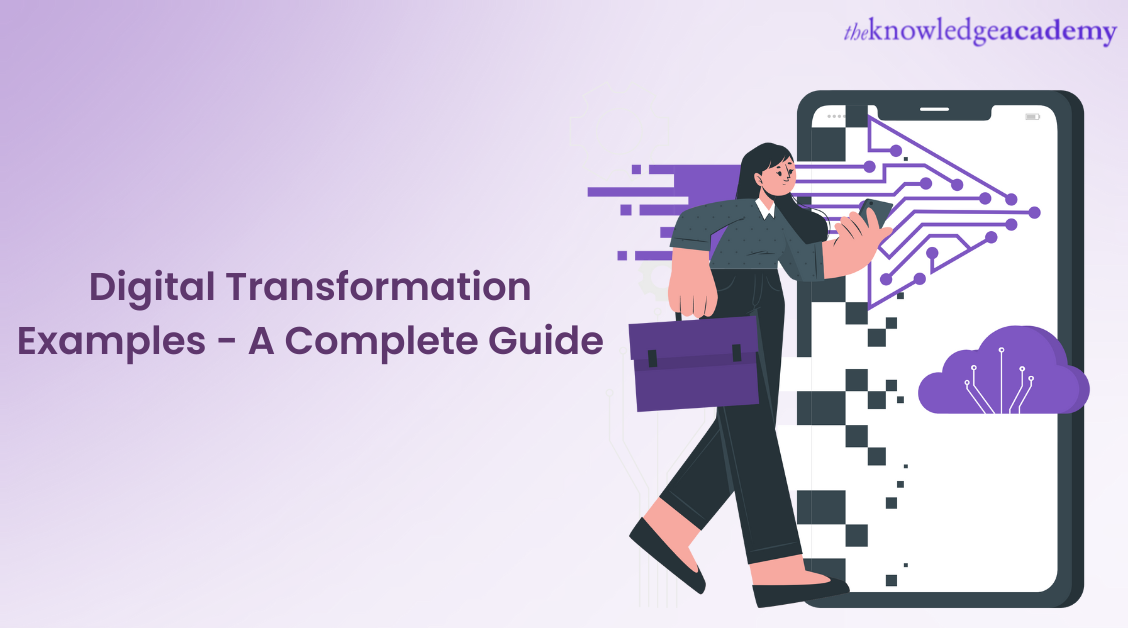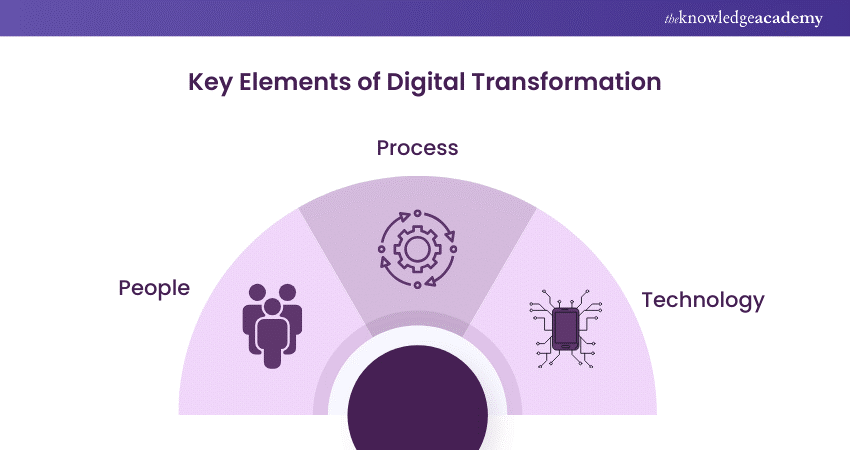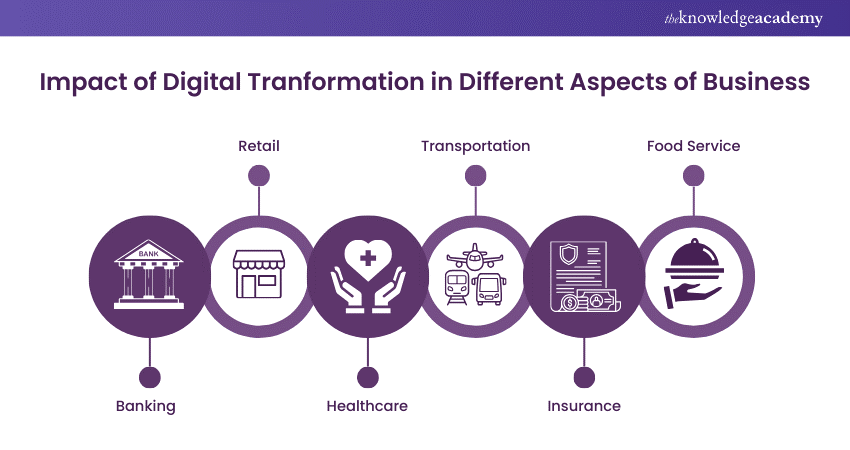We may not have the course you’re looking for. If you enquire or give us a call on +61 1-800-150644 and speak to our training experts, we may still be able to help with your training requirements.
Training Outcomes Within Your Budget!
We ensure quality, budget-alignment, and timely delivery by our expert instructors.

Digital Transformation is a concept dating back to the early 2000s and has permeated every industry there is. From retail to healthcare, from entertainment to education, there are many Digital Transformation Examples that show how businesses have innovated and grown with digitisation. However, it also shocks the operations and culture of the organisations. With changing consumer preferences and the pandemic, digital transformation was more essential than ever.
According to a study by Statista, the global expenditure on Digital Transformation is estimated to touch USD 2.6 trillion GBPby 2026. The best approach for digitising a business was extending business solutions to cloud storage. In another survey by PTC, improving operational efficiency comprised 40% of digitisation benefits. Check out this blog to learn about successful Digital Transformation Examples, strategies using technology, and processes to grow your business.
Table of Contents
1) What does successful Digital Transformation mean?
2) Understanding the components of Digital Transformation
3) Digital Transformation Examples
a) Banking
b) Retail
c) Healthcare
d) Transportation
e) Insurance
f) Food Services
4) Conclusion
What does successful Digital Transformation mean?
Successful Digital Transformation means using digital technologies to change how a business operates and delivers value to its customers, employees, and stakeholders. It is not just about adopting new tools or processes but about reimagining the entire business model and culture. A successful Digital Transformation requires a customer-driven, digital-first approach that leverages data, AI, automation, cloud, and other technologies to create intelligent workflows, faster and smarter decision-making, and real-time response to market disruptions.
Some Digital Transformation Examples are:
a) Domino’s transformed from a pizza delivery company to a digital powerhouse that offers online ordering, mobile apps, voice assistants, GPS tracking, and loyalty programs.
b) Nike used digital technologies to enhance its customer experience, product innovation, and brand engagement. Nike created a digital ecosystem that includes mobile apps, wearable devices, online platforms, and social media.
c) GE shifted from a traditional industrial manufacturer to a digital leader that offers software solutions, data analytics, and IoT devices for various industries. GE created a digital platform called Predix that connects machines, data, and people.

Understanding the components of Digital Transformation
Digital Transformation is where organisations integrate technology into their business, intending to drive change. Digital Transformation emphasises the ‘digital’ perspective of a business process, which must be customer-focused in nature.
Digitally transforming an organisation’s business process usually calls for a heavy budget. Organisations should remember to focus on aspects of the business such as culture and leadership, the agility of the team and operations, training the workforce for digitisation, and so on. The focus on these aspects will be more beneficial than investing most of the budget in cutting-edge technology.
Digital Transformation stands on three pillars that help the company iteratively assess its processes and outcomes. Here are the three pillars explained in detail to help you understand their significance:

People
A business always begins with its people, which is why the business process must revolve around the customer. The ‘people’ in question refer to both the customers and the employees. The relationship between the employees and the customers should not be overlooked.
A business has to understand and practice transparency because its people are its focus. The quote ‘half-baked information can be dangerous’ illustrates how managers or leaders should trust their own knowledge. Confident managers translate to confident employees.
Transformation involves a lot of change, and before implementing it, it is important to answer a couple of questions -
a) Who is affected by it the most?
b) Why do we need it?
The affected are usually the investors or stakeholders. The stakeholders involve the managers, employees, business partners and even vendors. This change is necessary because it helps organisations adapt to the evolving future of digitised work cultures.
Although Digital Transformation must be customer-centric in nature, it needs to be a two-way street. It is not only directed to the customers and stakeholders but also the managers. This two-way street can be referred to as a ‘feedback loop’ where the stakeholders are spoken to directly by the customers. It’s crucial to have a positive experience with the change taking place because this encourages better communication and managerial support.
Another important element of Digital Transformation is Machine Learning. It addresses the concern of Artificial Intelligence posing a threat to jobs. The manager should take it into their hands to reassure the team, re-instilling confidence as a result. The confidence of the team players is key to starting the transformation because their drive will keep the momentum going strong.
Dissect Artificial Intelligence and its principles through our comprehensive Introduction to AI Course Today!
Process
After the vision has been realised and the whole team is confident about their starting point, the next step is understanding their target customer. The previous section discussed a ‘feedback loop’ which bridges the communication between the customer and the organisation. This loop helps the team understand exactly who their customers are and what products they want to purchase.
Customer behaviour is an important aspect of the feedback loop, which comes of immense help to the team. Customer behaviour can be of two kinds, direct and indirect. The direct kind is where the customer gives feedback directly to the organisation. Direct feedback is generally taken in through customer feedback forms through Retention Emails or even by calling customers directly. Indirect feedback is how the customers utilise the product or how they purchase it in the first place. The concerns faced during the product use or purchase are generally referred to as ‘pain points’. ‘Pain points’ can be shared with the team via company agents or customer feedback surveys.
Customers want simplicity in their product purchases, delivery and use. The most important thing they wish for is the ease of product use. Furthermore, a smooth process for the customer results in product use as it was designed, as well as precise data collection for the organisation.
Technology
Any organisation undergoing Digital Transformation needs to know how to invest judiciously. Investing in technology which does its job as it should achieve the necessary outcome, is the sign of a careful yet ambitious organisation. A manager might believe an investment-heavy plan is the only way out for a Digital Transformation. However, a little introspection will save them by leveraging the value and making incremental investments in the long run.
The idea that a company must invest heavily in state-of-the-art technology is a traditional approach, considering the rapidly evolving world. Now the incremental investments can be directed toward building a robust tech infrastructure which would be cloud-based.
Digital Transformation Examples

Digital Transformation is the process of using digital technologies to improve or transform various aspects of a business, such as products, services, operations, or customer experience. It can help businesses gain a competitive edge, increase efficiency, reduce costs, and foster innovation. Here are some Digital Transformation Examples in different industries:
Banking
The Banking sector has undergone a myriad of changes in Digital Transformation. The changes involve shifts to mobile banking and apps. Mobile banking enables customers to upgrade to cardless payments using Google Pay and Apple Pay. Interestingly, the introduction of Apple Watches disrupted the watch market by including smartphone functionality.
Many top banking organisations introduced innovations to improve financial operations for the better. For example, Capital One transformed banking by leveraging its software processes. The MNC came out with a massive number of Artificial Intelligence patents to its name.
Another example would be Intergiro, a business offering multi-currency bank accounts as well as issuing cards across Europe. Intergiro automated its payroll systems and integrated its apps for wallets and holding bank cards.
The third example would be of integrating Machine Learning into your company's Digital Transformation. JP Morgan Chase launched the 'Onyx Lounge' in a popular blockchain-based metaverse called 'Decentraland'. Onyx Lounge allows the banking company to have a virtual presence as a bank where customers can virtually bank for digital blockchain-based land and make cross-border payments. According to a report by MarketsandMarkets, the market for global digital banking platforms is estimated to reach 10.9 billion GBP by 2026. With respect to customers of digital banking, a Statista study predicts a density of 2.5 billion customers using digital banking services by 2024.
Retail
Digital Transformation in the retail industry results in a few significant changes. The changes involve new services and improved operations post-transformation.
Note that any enhancements made must be large enough to be considered meaningful. The processes must be redefined to create a good customer engagement strategy using technology. As customer experiences evolve, the retail industry must adapt and evolve to serve customers accordingly.
For example, Nike launched new concept stores and offered more membership opportunities to improve the overall customer experience on the brand’s application. Thanks to data analytics and an emphasized focus on customers, Nike witnessed a significant transformation. According to Capital.com, Nike’s stock price grew from USD52 to nearly USD90 in two years.
Healthcare
Healthcare is a sector where Digital Transformation has seen an enormous improvement. Digital Transformation has been synonymous with Virtual Reality, such that it changed the landscape of patient care. The vast benefits offered to staff and patients are one of the most positive impacts of Digital Transformation on the healthcare industry.
Virtual Reality has boomed and is expected to grow by nearly USD 71.27 billion GBP by 2026, according to research by GlobeNewsWire. This boom is a reminder of how paper records have evolved to cloud-based digital models, which can be referred to as a massive leap for digital healthcare.
How does Virtual Reality actually help the healthcare industry anyways? Let’s discuss the specifics as shown below:
1) Pain reduction therapy: Virtual Reality can aid in Pain reduction for patients by letting them use VR applications which are specially designed to provide meditative environments and soundscapes. These applications offer guided imagery and even cognitive behavioural practices through their environments. As a result, a notable boost is observed in the patient’s mood.
2) VR Simulations: VR simulations can be used by healthcare practitioners and even students to rehearse surgeries in the virtual environment. Haptic controllers can also be of great use to add another dimension of experience through haptic feedback. Informative simulations can guide the users through the required steps. Doctors can also leverage VR technology to educate patients about procedures. Aesthetically relaxing virtual environments can immensely benefit patients and make the doctors' tasks much easier.
3) Speedy recovery for therapy: VR experiences can be tailor-made for each patient’s requirements through training exercises programmed with ML algorithms. These exercises can potentially speed up patient recovery.
Create immersive environments for educational simulations by learning the concepts of visual rendering and auditory perception. Sign up for the Virtual Reality (VR) Training course now!
Transportation
What might Transportation have to do with Digital Transformation? Take Tesla, a mainstream name in the Electric Automotive Industry. In addition to the automotive industry, the company also caused a disruption to the data industry and clean energy.
Its driverless feature is a prime factor in the market of Digital Transformation, owing to the reason that its AI architecture is dependent on the neural network 'Dojo'. Dojo was designed to process enormous volumes of data from camera images up to four times faster than any other computing system.
The feature of AI integrated into Tesla vehicles makes it a technology company rather than an automotive company. This is because the company owes its glory to its reputation as an autonomous technology giant. The company takes full advantage of AI and Big Data analytics to make the glory possible.
According to GlobalData, the annual expenditure of Tesla was $3.6 billion GBP in 2021, of which a major portion was in software acquisition and vendor hardware. Tesla's process of collecting live vehicle data to train its algorithms for feeding its AI drives its performance to stand out in tech markets.
Insurance
Do the terms Insurance and Digital Transformation paint any pictures for you? Insurance has been taken majorly online compared to its rich tradition of heavy paperwork. Be it access to documents or using your phone to file your claims conveniently, creating online portals has driven considerable change in the insurance industry.
For example, the car insurance company Root operates completely from its mobile application. A consumer can opt for new insurance with only a few clicks. The company's USP is how it rewards its users with automatic savings to their accounts by measuring how safely they drive.
Food Services
The concept of Digital Transformation in Food Services is quite a no-brainer. To begin with, Digitised food services are not new. Online food delivery services go as back as 1995 when World Wide Waiter came up with its web portal in North California. The idea of Digital Transformation entails a great food experience combined with technology to bring restaurants closer to customers.
While food businesses had their equal share of wrecks and bugs in their technology infrastructure, the pandemic pushed them to fix themselves.
Conclusion
Using some Digital Transformation Examples, we show how digitisation has affected all the industrial sectors. Digital transformation has brought positive outcomes for every industry, but also some challenges. Our blog emphasises that the customer is the key for any business success, and that digital transformation demands changing the organisation’s culture and goals, as well as how people collaborate, create value, and get feedback.
Learn the tools necessary for Digital Transformation to grow your brand. Sign up for the Digital Transformation Certification Course now!
Frequently Asked Questions

Digital Transformation (DT) is the use of technology to improve the performance or reach of a business. Some of the benefits of DT are:
a) Enhanced customer experience: DT helps businesses meet the current and future needs of their customers and deliver better value.
b) Increased efficiency and productivity: DT enables businesses to work smarter and faster, reduce costs, and improve quality.
c) Innovation and growth: DT helps businesses leverage new technologies and strategies to create new products, services, and business models.

The three main components of Digital Transformation are:
a) Organisational culture and agility: It involves fostering a mindset that embraces innovation, adaptability, and continuous learning within the organisation.
b) Digital technology adoption: It involves integrating and utilising advanced digital tools within the organisation’s core operations and business processes.
c) Data-driven decision-making: It involves ensuring that key decisions, actions, and processes are strongly influenced by data-driven insights rather than by human intuition.

The Knowledge Academy takes global learning to new heights, offering over 30,000 online courses across 490+ locations in 220 countries. This expansive reach ensures accessibility and convenience for learners worldwide.
Alongside our diverse Online Course Catalogue, encompassing 17 major categories, we go the extra mile by providing a plethora of free educational Online Resources like News updates, Blogs, videos, webinars, and interview questions. Tailoring learning experiences further, professionals can maximise value with customisable Course Bundles of TKA.

The Knowledge Academy’s Knowledge Pass, a prepaid voucher, adds another layer of flexibility, allowing course bookings over a 12-month period. Join us on a journey where education knows no bounds.

Discover Digital Transformation courses with The Knowledge Academy, Offering Digital Transformation Certification Courses. Designed for diverse skill levels, these courses provide a comprehensive understanding of Digital Transformation methodologies.
Whether you are starting your journey or aiming to elevate your Digital Transformation expertise, immerse yourself in our Business Improvement blogs to discover more insights!
Upcoming Business Improvement Resources Batches & Dates
Date
 Digital Transformation Certification
Digital Transformation Certification
Thu 23rd Jan 2025
Thu 10th Apr 2025
Thu 15th May 2025
Thu 17th Jul 2025
Thu 4th Sep 2025
Thu 13th Nov 2025







 Top Rated Course
Top Rated Course


 If you wish to make any changes to your course, please
If you wish to make any changes to your course, please


